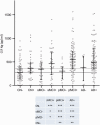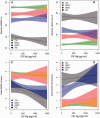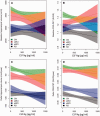Cerebrospinal fluid neurogranin: relation to cognition and neurodegeneration in Alzheimer's disease
- PMID: 26373605
- PMCID: PMC4643642
- DOI: 10.1093/brain/awv267
Cerebrospinal fluid neurogranin: relation to cognition and neurodegeneration in Alzheimer's disease
Abstract
Synaptic dysfunction is linked to cognitive symptoms in Alzheimer's disease. Thus, measurement of synapse proteins in cerebrospinal fluid may be useful biomarkers to monitor synaptic degeneration. Cerebrospinal fluid levels of the postsynaptic protein neurogranin are increased in Alzheimer's disease, including in the predementia stage of the disease. Here, we tested the performance of cerebrospinal fluid neurogranin to predict cognitive decline and brain injury in the Alzheimer's Disease Neuroimaging Initiative study. An in-house immunoassay was used to analyse neurogranin in cerebrospinal fluid samples from a cohort of patients who at recruitment were diagnosed as having Alzheimer's disease with dementia (n = 95) or mild cognitive impairment (n = 173), as well as in cognitively normal subjects (n = 110). Patients with mild cognitive impairment were grouped into those that remained cognitively stable for at least 2 years (stable mild cognitive impairment) and those who progressed to Alzheimer's disease dementia during follow-up (progressive mild cognitive impairment). Correlations were tested between baseline cerebrospinal fluid neurogranin levels and baseline and longitudinal cognitive impairment, brain atrophy and glucose metabolism within each diagnostic group. Cerebrospinal fluid neurogranin was increased in patients with Alzheimer's disease dementia (P < 0.001), progressive mild cognitive impairment (P < 0.001) and stable mild cognitive impairment (P < 0.05) compared with controls, and in Alzheimer's disease dementia (P < 0.01) and progressive mild cognitive impairment (P < 0.05) compared with stable mild cognitive impairment. In the mild cognitive impairment group, high baseline cerebrospinal fluid neurogranin levels predicted cognitive decline as reflected by decreased Mini-Mental State Examination (P < 0.001) and increased Alzheimer's Disease Assessment Scale-cognitive subscale (P < 0.001) scores at clinical follow-up. In addition, high baseline cerebrospinal fluid neurogranin levels in the mild cognitive impairment group correlated with longitudinal reductions in cortical glucose metabolism (P < 0.001) and hippocampal volume (P < 0.001) at clinical follow-up. Furthermore, within the progressive mild cognitive impairment group, elevated cerebrospinal fluid neurogranin levels were associated with accelerated deterioration in Alzheimer's Disease Assessment Scale-cognitive subscale (β = 0.0017, P = 0.01). These data demonstrate that cerebrospinal fluid neurogranin is increased already at the early clinical stage of Alzheimer's disease and predicts cognitive deterioration and disease-associated changes in metabolic and structural biomarkers over time.
Keywords: Alzheimer’s disease; biomarker; cerebrospinal fluid; mild cognitive impairment; neurogranin.
© The Author (2015). Published by Oxford University Press on behalf of the Guarantors of Brain. All rights reserved. For Permissions, please email: journals.permissions@oup.com.
Figures







Comment in
-
Alzheimer disease: neurogranin in the CSF signals early Alzheimer disease and predicts disease progression.Nat Rev Neurol. 2015 Nov;11(11):609. doi: 10.1038/nrneurol.2015.178. Epub 2015 Sep 29. Nat Rev Neurol. 2015. PMID: 26416540 No abstract available.
Similar articles
-
Association of cerebrospinal fluid neurogranin levels with cognition and neurodegeneration in Alzheimer's disease.Aging (Albany NY). 2020 May 18;12(10):9365-9379. doi: 10.18632/aging.103211. Epub 2020 May 18. Aging (Albany NY). 2020. PMID: 32421689 Free PMC article.
-
Association Between Longitudinal Plasma Neurofilament Light and Neurodegeneration in Patients With Alzheimer Disease.JAMA Neurol. 2019 Jul 1;76(7):791-799. doi: 10.1001/jamaneurol.2019.0765. JAMA Neurol. 2019. PMID: 31009028 Free PMC article.
-
Cerebrospinal fluid synaptosomal-associated protein 25 is a key player in synaptic degeneration in mild cognitive impairment and Alzheimer's disease.Alzheimers Res Ther. 2018 Aug 16;10(1):80. doi: 10.1186/s13195-018-0407-6. Alzheimers Res Ther. 2018. PMID: 30115118 Free PMC article.
-
Structural magnetic resonance imaging for the early diagnosis of dementia due to Alzheimer's disease in people with mild cognitive impairment.Cochrane Database Syst Rev. 2020 Mar 2;3(3):CD009628. doi: 10.1002/14651858.CD009628.pub2. Cochrane Database Syst Rev. 2020. PMID: 32119112 Free PMC article.
-
A meta-analysis on CSF neurogranin levels for the diagnosis of Alzheimer's disease and mild cognitive impairment.Aging Clin Exp Res. 2020 Sep;32(9):1639-1646. doi: 10.1007/s40520-019-01326-z. Epub 2019 Aug 28. Aging Clin Exp Res. 2020. PMID: 31463927 Review.
Cited by
-
Association of CSF proteins with tau and amyloid β levels in asymptomatic 70-year-olds.Alzheimers Res Ther. 2021 Mar 2;13(1):54. doi: 10.1186/s13195-021-00789-5. Alzheimers Res Ther. 2021. PMID: 33653397 Free PMC article.
-
Cerebrospinal Fluid Sphingomyelins in Alzheimer's Disease, Neurodegeneration, and Neuroinflammation.J Alzheimers Dis. 2022;90(2):667-680. doi: 10.3233/JAD-220349. J Alzheimers Dis. 2022. PMID: 36155504 Free PMC article.
-
Exploring Intrinsic Disorder in Human Synucleins and Associated Proteins.Int J Mol Sci. 2024 Aug 1;25(15):8399. doi: 10.3390/ijms25158399. Int J Mol Sci. 2024. PMID: 39125972 Free PMC article.
-
Mild Cognitive Impairment Staging Yields Genetic Susceptibility, Biomarker, and Neuroimaging Differences.Front Aging Neurosci. 2020 Jun 5;12:139. doi: 10.3389/fnagi.2020.00139. eCollection 2020. Front Aging Neurosci. 2020. PMID: 32581762 Free PMC article.
-
Fluid Biomarkers in Alzheimer's Disease and Other Neurodegenerative Disorders: Toward Integrative Diagnostic Frameworks and Tailored Treatments.Diagnostics (Basel). 2022 Mar 24;12(4):796. doi: 10.3390/diagnostics12040796. Diagnostics (Basel). 2022. PMID: 35453843 Free PMC article. Review.
References
-
- Alvarez-Bolado G, Rodriguez-Sanchez P, Tejero-Diez P, Fairen A, Diez-Guerra FJ. Neurogranin in the development of the rat telencephalon. Neuroscience 1996; 73: 565–80. - PubMed
-
- Baudier J, Deloulme JC, Van Dorsselaer A, Black D, Matthes HW. Purification and characterization of a brain-specific protein kinase C substrate, neurogranin (p17). Identification of a consensus amino acid sequence between neurogranin and neuromodulin (GAP43) that corresponds to the protein kinase C phosphorylation site and the calmodulin-binding domain. J Biol Chem 1991; 266: 229–37. - PubMed
-
- Bertoni-Freddari C, Fattoretti P, Casoli T, Caselli U, Meier-Ruge W. Deterioration threshold of synaptic morphology in aging and senile dementia of Alzheimer’s type. Anal Quant Cytol Histol 1996; 18: 209–13. - PubMed
-
- Blennow K, Bogdanovic N, Alafuzoff I, Ekman R, Davidsson P. Synaptic pathology in Alzheimer’s disease: relation to severity of dementia, but not to senile plaques, neurofibrillary tangles, or the ApoE4 allele. J Neural Transm 1996; 103: 603–18. - PubMed
-
- Blennow K, Hampel H, Weiner M, Zetterberg H. Cerebrospinal fluid and plasma biomarkers in Alzheimer disease. Nat Rev Neurol 2010; 6: 131–44. - PubMed
Publication types
MeSH terms
Substances
Grants and funding
LinkOut - more resources
Full Text Sources
Other Literature Sources
Medical

